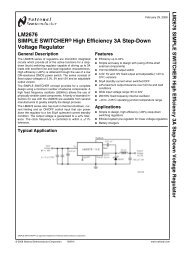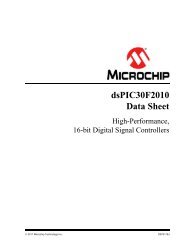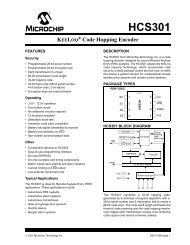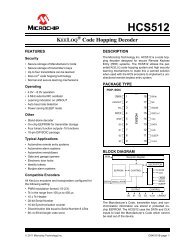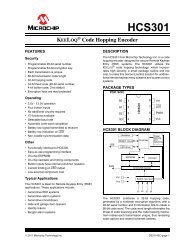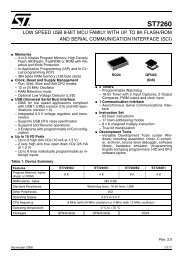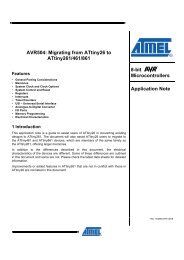You also want an ePaper? Increase the reach of your titles
YUMPU automatically turns print PDFs into web optimized ePapers that Google loves.
General-purpose input/outputs<br />
<strong>STM32W108C8</strong><br />
that GPIO activity caused a wake event, but not which specific GPIO was responsible.<br />
Instead, software should read the state of the GPIOs on waking to determine the cause of<br />
the event.<br />
The register GPIO_WAKEFILT contains bits to enable digital filtering of the external wakeup<br />
event sources: the GPIO pins, SC1 activity, SC2 activity, and IRQD. The digital filter<br />
operates by taking samples based on the (nominal) 10 kHz RC oscillator. If three samples in<br />
a row all have the same logic value, and this sampled logic value is different from the logic<br />
value seen upon entering sleep, the filter outputs a wakeup event.<br />
In order to use GPIO pins to wake the <strong>STM32W108C8</strong> from deep sleep, the GPIO_WAKE<br />
bit in the WAKE_SEL register must be set. Waking up from GPIO activity does not work with<br />
pins configured for analog mode since the digital logic input is always set to 1 when in<br />
analog mode. Refer to Section 6: System modules on page 32 for information on the<br />
<strong>STM32W108C8</strong>'s power management and sleep modes.<br />
8.2 External interrupts<br />
The <strong>STM32W108C8</strong> can use up to four external interrupt sources (IRQA, IRQB, IRQC, and<br />
IRQD), each with its own top level NVIC interrupt vector. Since these external interrupt<br />
sources connect to the standard GPIO input path, an external interrupt pin may<br />
simultaneously be used by a peripheral device or even configured as an output. Analog<br />
mode is the only GPIO configuration that is not compatible with using a pin as an external<br />
interrupt.<br />
External interrupts have individual triggering and filtering options selected using the<br />
registers GPIO_INTCFGA, GPIO_INTCFGB, GPIO_INTCFGC, and GPIO_INTCFGD. The<br />
bit field GPIO_INTMOD of the GPIO_INTCFGx register enables IRQx's second level<br />
interrupt and selects the triggering mode: 0 is disabled; 1 for rising edge; 2 for falling edge; 3<br />
for both edges; 4 for active high level; 5 for active low level. The minimum width needed to<br />
latch an unfiltered external interrupt in both level- and edge-triggered mode is 80 ns. With<br />
the digital filter enabled (the GPIO_INTFILT bit in the GPIO_INTCFGx register is set), the<br />
minimum width needed is 450 ns.<br />
The register INT_GPIOFLAG is the second-level interrupt flag register that indicates<br />
pending external interrupts. Writing 1 to a bit in the INT_GPIOFLAG register clears the flag<br />
while writing 0 has no effect. If the interrupt is level-triggered, the flag bit is set again<br />
immediately after being cleared if its input is still in the active state.<br />
Two of the four external interrupts, IRQA and IRQB, have fixed pin assignments. The other<br />
two external interrupts, IRQC and IRQD, can use any GPIO pin. The GPIO_IRQCSEL and<br />
GPIO_IRQDSEL registers specify the GPIO pins assigned to IRQC and IRQD, respectively.<br />
Table 24 shows how the GPIO_IRQCSEL and GPIO_IRQDSEL register values select the<br />
GPIO pin used for the external interrupt.<br />
Table 24.<br />
IRQC/D GPIO selection<br />
GPIO_IRQxSEL<br />
GPIO<br />
GPIO_IRQxSE<br />
L<br />
GPIO<br />
GPIO_IRQxSE<br />
L<br />
GPIO<br />
0 PA0 8 PB0 16 PC0<br />
1 PA1 9 PB1 17 PC1<br />
2 PA2 10 PB2 18 PC2<br />
61/215 Doc ID 018587 Rev 2





